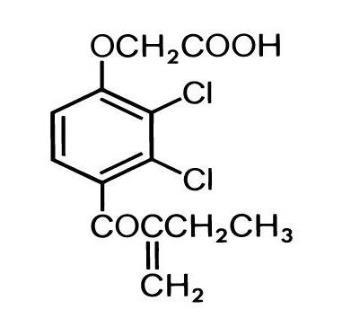Ethacrynic Sodium
Generic name: ethacrynic acid
Dosage form: tablet
Drug class:Loop diuretics
Medically reviewed by Drugs.com. Last updated on Apr 21, 2022.
On This Page
Ethacrynic acid is a potent diuretic which, if given in excessive amounts, may lead to profound diuresis with water and electrolyte depletion. Therefore, careful medical supervision is required, and dose and dose schedule must be adjusted to the individual patient's needs (see DOSAGE AND ADMINISTRATION).
Ethacrynic Sodium Description
Ethacrynic acid is an unsaturated ketone derivative of an aryloxyacetic acid. It is designated chemically as [2, 3-dichloro-4-(2-methylene-1-oxobutyl) phenoxy] acetic acid, and has a molecular weight of 303.14. Ethacrynic acid, USP is a white, or practically white, crystalline powder, very slightly soluble in water, but soluble in most organic solvents such as alcohols, chloroform, and benzene. Its empirical formula is C13H12Cl2O4 and its structural formula is:

Ethacrynic acid tablets, USP are supplied as 25 mg tablets for oral use. The tablets contain the following inactive ingredients: lactose monohydrate, magnesium stearate, pregelatinized starch (corn) and talc.
Ethacrynic Sodium - Clinical Pharmacology
Pharmacokinetics and Metabolism
Ethacrynic acid acts on the ascending limb of the loop of Henle and on the proximal and distal tubules. Urinary output is usually dose dependent and related to the magnitude of fluid accumulation. Water and electrolyte excretion may be increased several times over that observed with thiazide diuretics, since ethacrynic acid inhibits reabsorption of a much greater proportion of filtered sodium than most other diuretic agents. Therefore, ethacrynic acid is effective in many patients who have significant degrees of renal insufficiency (see WARNINGS concerning deafness). Ethacrynic acid has little or no effect on glomerular filtration or on renal blood flow, except following pronounced reductions in plasma volume when associated with rapid diuresis....



